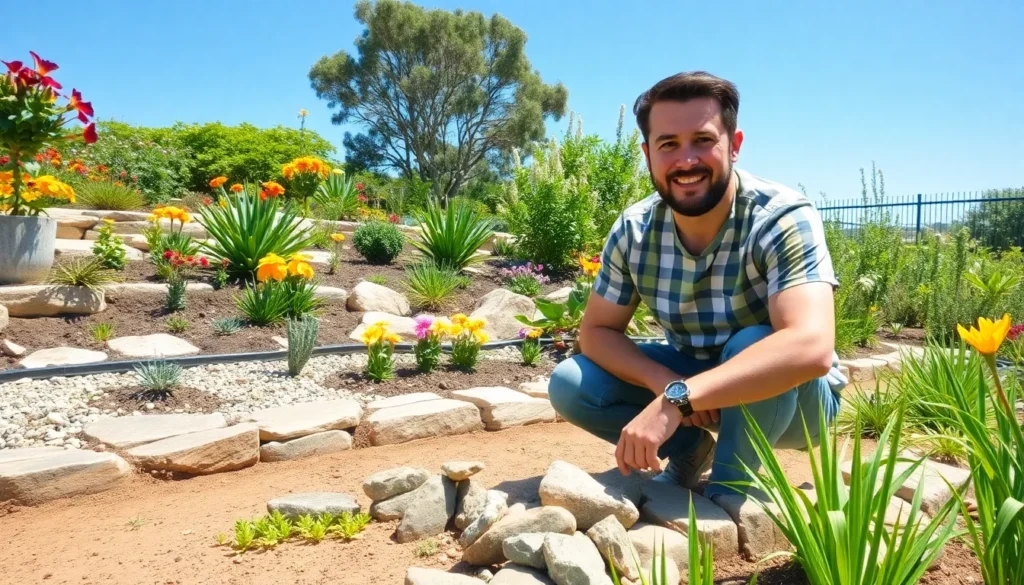Creating beautiful garden borders that can withstand Australia’s diverse climate conditions doesn’t have to expensive or require professional landscaping skills. We’ve discovered that the right edging can transform any outdoor space from ordinary to extraordinary while defining planting areas and preventing grass from invading your precious flower beds.
From coastal regions battling salt spray to inland areas facing extreme heat, Australian gardens present unique challenges that demand smart edging answers. We’ll show you proven techniques using locally available materials that not only look stunning but also stand up to our harsh weather conditions year after year.
Whether you’re working with native Australian plants or creating a cottage garden oasis, the perfect edging solution exists for your space and budget. We’ve compiled the most effective garden edging ideas that Australian homeowners are using to create professional-looking landscapes without the hefty price tag.
Natural Stone Edging Solutions for Australian Gardens
Natural stone materials offer exceptional durability and weather resistance for Australian gardens. We’ve found these options consistently perform well across diverse climate conditions.
Sandstone Borders
Sandstone edging creates warm, honey-colored borders that complement native Australian plants like grevilleas and bottlebrush. This sedimentary rock naturally resists our harsh UV conditions while providing excellent drainage around garden beds. We recommend using blocks measuring 300mm x 150mm x 100mm for stability and visual impact.
Installing sandstone requires minimal excavation since the material’s weight provides natural anchoring. Professional landscapers often charge $45-60 per linear meter, but DIY installation reduces costs to approximately $25-35 per meter. The stone’s porous nature allows water penetration while preventing soil spillage into lawn areas.
Most Australian quarries supply sandstone in cream, yellow, and brown tones that age beautifully in our climate. We’ve observed that Hawkesbury sandstone particularly suits coastal gardens due to its salt resistance properties.
Bluestone Pathways
Bluestone delivers sophisticated charcoal-gray edging that works exceptionally well in contemporary Australian landscapes. This volcanic rock material withstands extreme temperature fluctuations from Darwin’s tropical heat to Melbourne’s cold winters. We typically install bluestone strips at 40mm thickness for optimal structural integrity.
Commercial suppliers offer bluestone in standard lengths of 600mm, 900mm, and 1200mm pieces. Installation costs range from $55-75 per linear meter professionally, while DIY projects average $35-45 per meter including materials. The stone’s dense composition prevents weed penetration and maintains clean lines for years.
Victorian quarries produce premium bluestone that’s become increasingly popular in Perth and Brisbane gardens. We’ve noticed this material pairs beautifully with silver-leafed plants like dusty miller and lamb’s ear.
River Rock Arrangements
River rock edging provides organic, curved borders using smooth stones ranging from 50mm to 150mm diameter. These naturally tumbled stones create flexible edging answers that follow garden contours without rigid geometric constraints. We source river rocks locally to reduce transportation costs and environmental impact.
Installation involves creating a shallow trench approximately 100mm deep and layering rocks to prevent shifting. Material costs typically range from $15-25 per linear meter, making this our most budget-friendly natural stone option. The varied sizes create visual texture while allowing water drainage between stones.
Australian suppliers offer river rocks in granite, basalt, and sandstone compositions with colors spanning gray, brown, and cream tones. We’ve found that mixing stone sizes creates more natural-looking borders that integrate seamlessly with established garden plantings.
Timber and Wood Edging Options
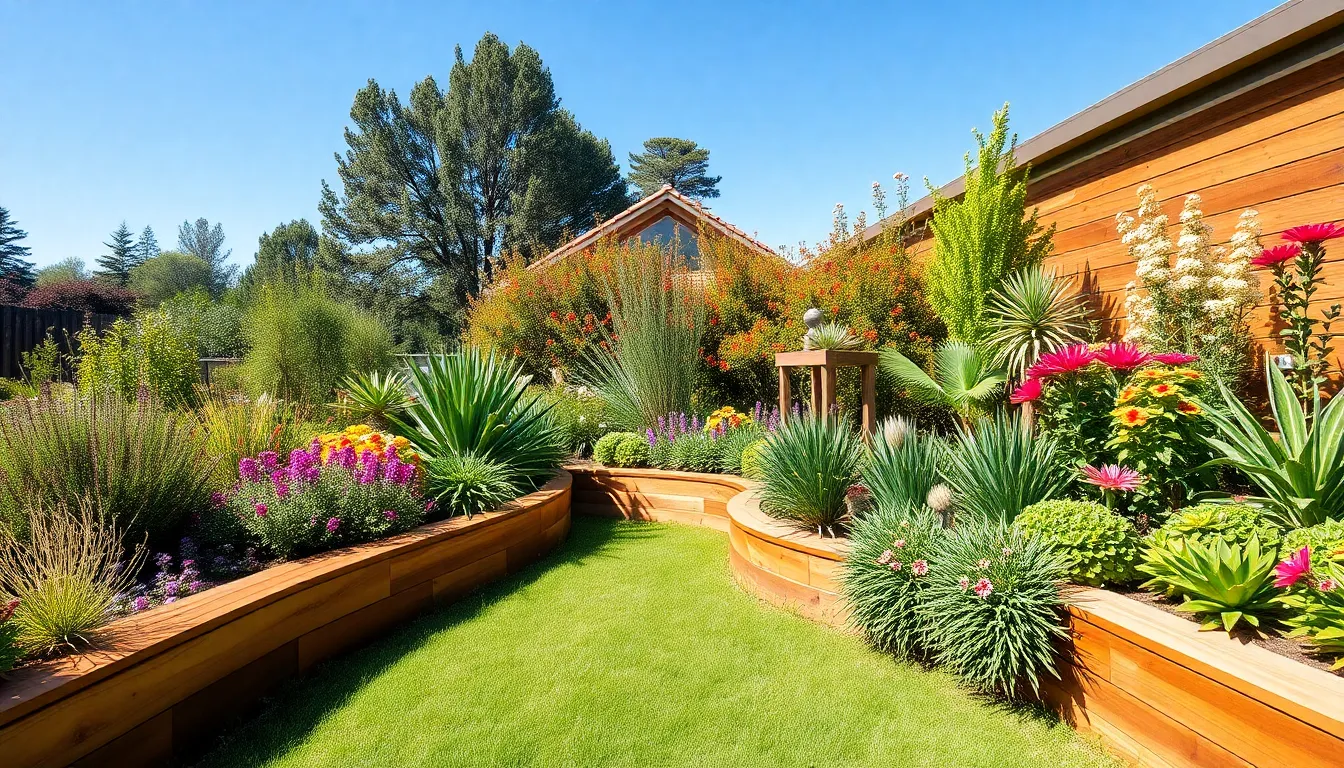
Timber edging offers the perfect balance of natural beauty and practical functionality for Australian gardens. We’ve found that wood materials create seamless transitions between different garden zones while providing the durability needed for our diverse climate conditions.
Treated Pine Sleepers
Treated pine sleepers deliver exceptional value for money when creating sturdy garden borders. Chemical treatment makes these sleepers resistant to rot and pest damage, ensuring they’ll withstand Australia’s challenging weather conditions year after year. We recommend using them for raised garden beds where their structural strength shines, supporting soil loads while maintaining clean lines between planting areas and pathways.
Installation requires minimal expertise, making treated pine sleepers ideal for weekend DIY projects. Their rustic appearance complements both native Australian plants and exotic garden varieties. Cost effectiveness combined with widespread availability means you can source these materials from most hardware stores across the country.
Hardwood Garden Borders
Hardwood edging transforms ordinary garden spaces into sophisticated outdoor environments. Jarrah, blackbutt, and spotted gum species offer natural resistance to weather and insects without requiring chemical treatments. We’ve observed that hardwood borders maintain their appearance longer than softwood alternatives, making them worthwhile investments for high visibility areas.
Premium aesthetics justify the higher initial cost when you consider their longevity and minimal maintenance requirements. These materials excel in formal garden designs where crisp, defined edges create visual impact. Durability makes hardwood particularly suitable for high traffic zones where children play or where frequent garden maintenance occurs.
Recycled Timber Features
Recycled timber brings unique character and environmental benefits to garden edging projects. Reclaimed materials from old pallets, fences, and demolished buildings create distinctive borders that tell stories while reducing waste. We appreciate how weathered textures and varied coloring add authentic charm that new materials simply can’t replicate.
Sustainability conscious gardeners find recycled timber aligns perfectly with eco friendly landscaping principles. Creative arrangements using different sized pieces allow for custom designs that follow natural garden contours. Cost savings compared to new timber make this option attractive for budget conscious homeowners who want distinctive results without premium material expenses.
Metal Edging Ideas for Modern Australian Landscapes
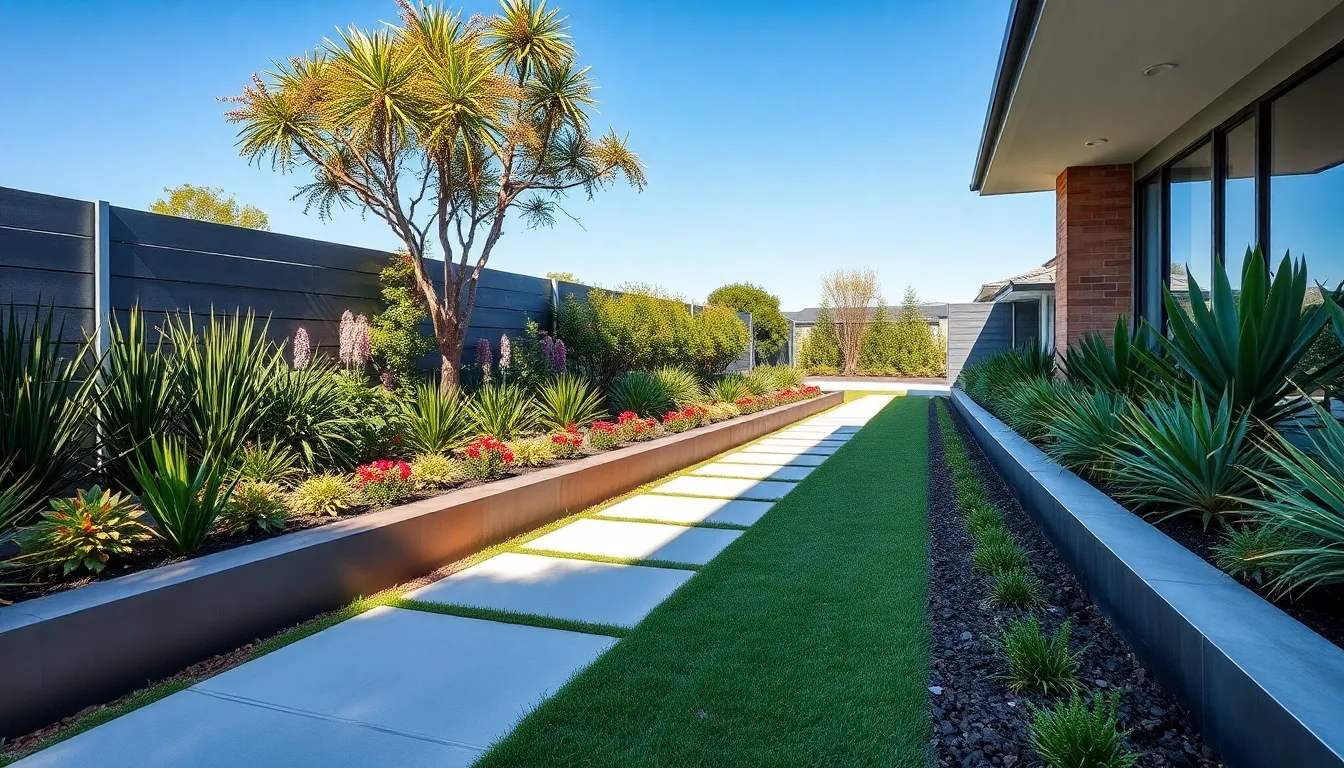
Modern Australian gardens benefit from metal edging answers that deliver both durability and contemporary style. We’ve found that metal options outperform traditional materials in harsh climates while requiring minimal ongoing maintenance.
Corten Steel Strips
Corten steel strips create striking garden borders with their distinctive weathered appearance. This weathering steel develops a protective rust-like patina over time, giving your industry an earthy, industrial aesthetic that perfectly complements Australian outdoor environments. We recommend corten steel for homeowners seeking a modern yet natural look that ages beautifully.
Installation proves straightforward since corten steel strips require minimal groundwork. These robust materials maintain their structural integrity in harsh Australian climates without warping or corroding quickly. The strips excel at creating clean, sharp lines for garden beds, pathways, and retaining walls.
Maintenance requirements stay minimal once the patina fully develops. Weather resistance makes corten steel an excellent long-term investment for Australian gardens facing extreme temperature fluctuations and seasonal weather changes.
Galvanized Steel Borders
Galvanized steel borders offer zinc coating protection against rust and corrosion. This coating makes them particularly practical for Australian gardens exposed to coastal conditions and frequent rainfall. We find galvanized steel provides excellent value since it’s typically more affordable than corten steel while delivering comparable durability.
Flexibility allows galvanized steel to form both curves and straight edges. This adaptability caters to various industry designs, from formal geometric layouts to flowing organic shapes. Installation becomes simple with minimal tools required – most systems can be hammered directly into the ground.
Containment capabilities help keep soil and mulch properly positioned. The neat, industrial finish complements modern garden aesthetics while providing practical border functionality that prevents material spillage onto pathways or lawn areas.
Aluminium Edging Systems
Aluminium edging systems deliver lightweight strength with complete rust resistance. These systems offer sleek, contemporary aesthetics that suit modern Australian garden designs perfectly. We’ve seen excellent results with Australian-manufactured options like Inspire® Modern Garden Edging, which feature innovative designs allowing easy installation without pegs or excessive digging.
Bendability enables creation of various shapes from straight lines to circular beds. This versatility makes aluminium ideal for creative industry designs requiring curved borders or unique geometric patterns. The material maintains its structural integrity while adapting to different garden layouts.
Safety features include rolled top edges protecting children and pets. Additional benefits cover secure underground piping management, preventing irrigation damage and maintaining system neatness. These practical advantages make aluminium edging systems particularly valuable for family-friendly Australian gardens requiring both style and functionality.
Brick and Masonry Garden Borders
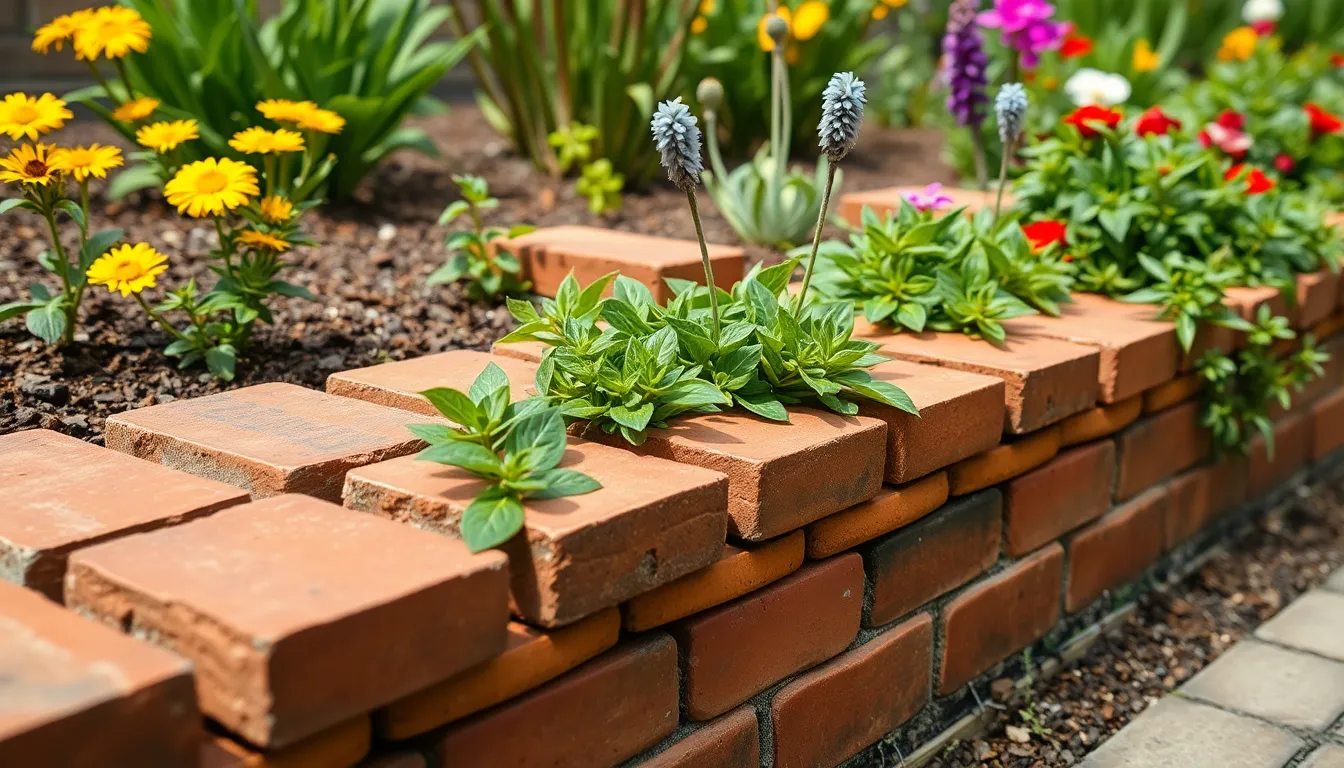
After exploring natural stone and contemporary metal options, we’re turning to the classic durability of brick and masonry answers that have defined Australian gardens for decades.
Traditional Clay Brick Edging
Traditional clay brick edging remains one of Australia’s most reliable garden border answers. We find that this method creates exceptionally neat garden borders while making lawn maintenance significantly easier by providing clear definition between grass and planting areas. Installation requires minimal excavation, and the bricks can be laid in various patterns including soldier course, sailor course, or header bond arrangements.
Durability stands as the primary advantage of clay brick borders, with properly installed edges lasting decades without replacement. We’ve observed that traditional red clay bricks complement both heritage homes and contemporary landscapes, creating visual cohesion throughout the property. Maintenance involves occasional releveling and weed removal between joints, making this an accessible option for most homeowners.
Cost effectiveness makes clay brick edging particularly attractive, with materials readily available at hardware stores across Australia for approximately $0.50 to $1.20 per brick depending on quality and finish.
Recycled Brick Features
Recycled brick features offer an environmentally conscious approach to garden edging that adds distinctive character to outdoor spaces. We’ve discovered that sourced materials from demolished buildings, old chimneys, and heritage structures provide unique textures and color variations impossible to achieve with new products. These weathered bricks blend seamlessly with established garden designs while supporting sustainable landscaping practices.
Installation flexibility allows recycled bricks to accommodate irregular garden contours and creative design concepts. We recommend sorting bricks by size and condition before installation, using the most uniform pieces for structural elements and incorporating damaged bricks as decorative accents or drainage features.
Character development through recycled materials creates gardens with authentic Australian heritage appeal, particularly effective in cottage garden settings and heritage property landscapes.
Concrete Block Designs
Concrete block designs deliver structured, contemporary garden borders that suit modern Australian homes and commercial landscapes. We’ve found these blocks exceptionally easy to install and maintain, requiring basic excavation and leveling skills that most DIY enthusiasts can master. Standard blocks measure 390mm x 190mm x 190mm, creating uniform lines that complement geometric garden layouts.
Versatility emerges through various concrete block styles including split face, smooth finish, and colored options that coordinate with existing hardscaping elements. We often recommend interlocking systems that eliminate mortar requirements while maintaining structural integrity against soil pressure and root growth.
Maintenance requirements remain minimal, with occasional cleaning and joint inspection ensuring long term performance in Australia’s diverse climate conditions.
Native Plant Edging Solutions
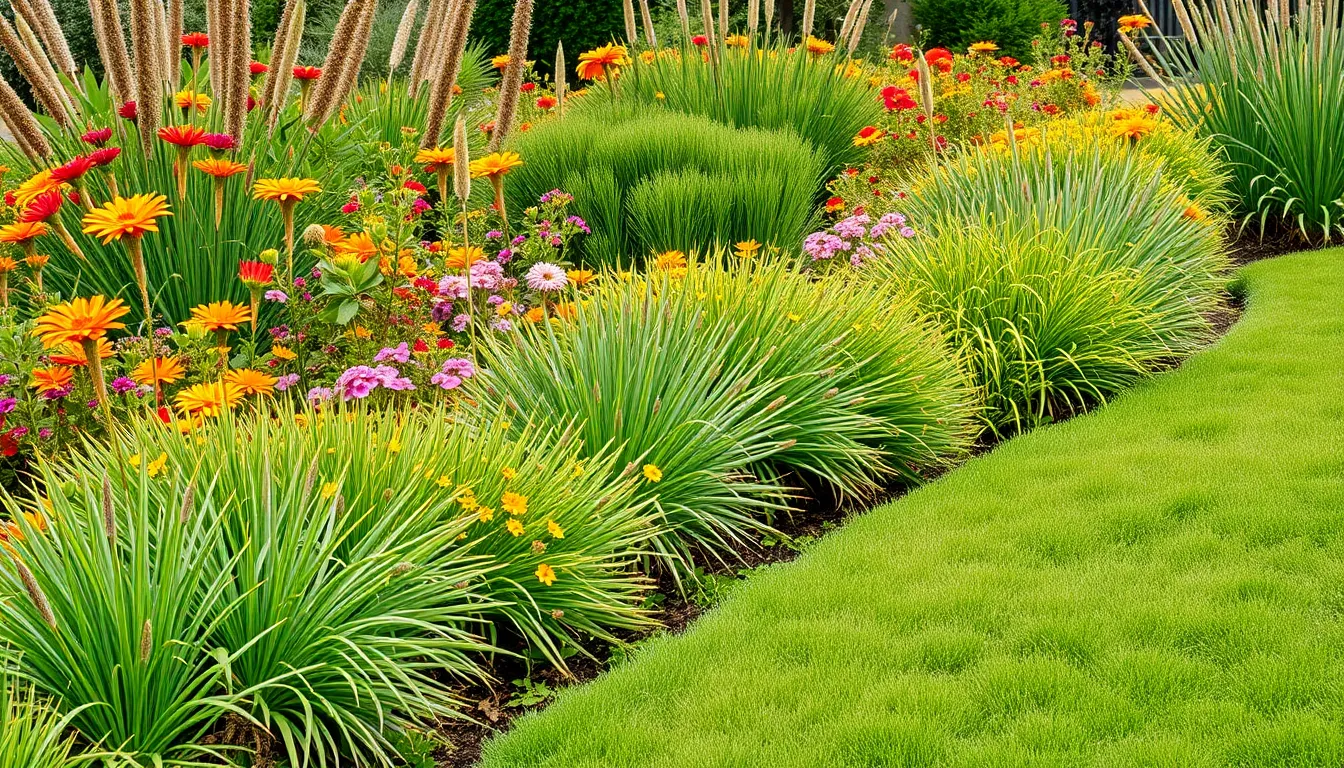
Australian gardens benefit tremendously from plant-based borders that naturally complement our unique industry. These living edges create stunning boundaries while supporting local ecosystems and reducing maintenance requirements.
Low-Growing Australian Natives
Kangaroo Paw creates exceptional pathway borders with its distinctive flowering stems that attract native birds and bees throughout the growing season. We recommend spacing these plants 30-40cm apart for optimal coverage without overcrowding. Their unique texture and vibrant colors make them perfect for contemporary Australian garden designs.
Dwarf Mondo Grass offers neat, compact borders that maintain clean lines year-round without blocking views of feature plants behind. This hardy native thrives in both full sun and partial shade conditions. Installation requires minimal soil preparation, making it an excellent choice for DIY garden projects.
Correa varieties provide dense, low-growing hedges that produce colorful tubular flowers from autumn through winter. These hardy shrubs tolerate coastal conditions and drought once established. Regular light pruning keeps borders tidy while encouraging continuous flowering that supports local wildlife.
Ornamental Grass Borders
Pennisetum species create ever-changing garden edges with their feathery plumes that sway gracefully in Australian breezes. These drought-tolerant grasses require minimal water once established and provide year-round interest. We suggest cutting them back annually in late winter to promote fresh growth and maintain neat borders.
Miscanthus varieties offer dramatic height and texture variations for larger garden beds and property boundaries. Their tolerance for various soil conditions makes them adaptable to different Australian climates. The silver and gold tones of their autumn foliage complement native plantings beautifully.
Both grass types establish quickly and create natural windbreaks that protect more delicate plants behind them. Their root systems help prevent soil erosion on sloped areas while requiring virtually no ongoing maintenance.
Succulent Garden Edges
Echeveria rosettes form striking geometric patterns along garden borders with their symmetrical leaf arrangements and occasional colorful flower spikes. These water-wise plants store moisture in their thick leaves, making them perfect for water-restricted areas. We recommend planting them in well-draining soil to prevent root rot during wet seasons.
Sedum varieties create colorful carpet-like borders that change appearance throughout the seasons with their diverse leaf colors and flowering periods. Their ability to spread naturally fills gaps between plantings over time. These hardy succulents require minimal care beyond occasional removal of spent flowers.
Succulent edges work particularly well in modern Australian gardens where water conservation is priority. Their sculptural qualities complement contemporary architecture while providing practical low-maintenance answers for busy homeowners.
Creative DIY Edging Projects

We love transforming everyday items into stunning garden borders that cost a fraction of professional installations. These recycled materials create unique edging answers while keeping waste out of landfills.
Bottle Border Installations
Glass bottles make eye-catching garden edging that adds instant color and texture to our industry borders. We arrange wine bottles, beer bottles, or decorative glass containers upside down along flower beds to create shimmering borders that catch sunlight beautifully. Installing these borders requires digging a shallow trench about 6 inches deep and positioning bottles neck-down for stability.
Different colored bottles create distinct visual effects throughout our gardens. Green wine bottles provide subtle earth tones that complement native Australian plants, while clear glass bottles reflect light and create sparkling accents along pathways. We can mix various bottle colors to match seasonal plantings or create rainbow patterns that appeal to children and visitors alike.
Tire Planter Edges
Upcycled car tires transform into functional planter borders that add height and structure to our garden designs. We paint old tires with weather-resistant exterior paint in colors that complement our industry themes, creating durable containers that withstand Australia’s harsh sun and seasonal weather changes. These tire planters work perfectly for growing herbs, small vegetables, or colorful annuals along garden edges.
Stacking multiple tires creates tiered effects that add vertical interest to flat garden spaces. Single tire installations work well for defining individual planting zones, while connected tire arrangements can border entire garden sections. We recommend using non-toxic paint specifically designed for rubber surfaces to ensure plant safety and longevity.
Bamboo Screening Options
Bamboo screening provides natural privacy borders that blend seamlessly with Australian garden aesthetics. We install bamboo panels or individual stakes to create living screens that filter wind while maintaining an organic appearance throughout our landscapes. This versatile material works particularly well in tropical and subtropical regions where bamboo naturally thrives.
Installing bamboo screens requires securing posts every 6 to 8 feet along the desired border line. We can arrange bamboo in lattice patterns for decorative screening or use solid panels for complete privacy around garden areas. Bamboo naturally weathers to attractive silver tones over time, requiring minimal maintenance while providing effective windbreaks for delicate plants.
Climate-Specific Edging Considerations
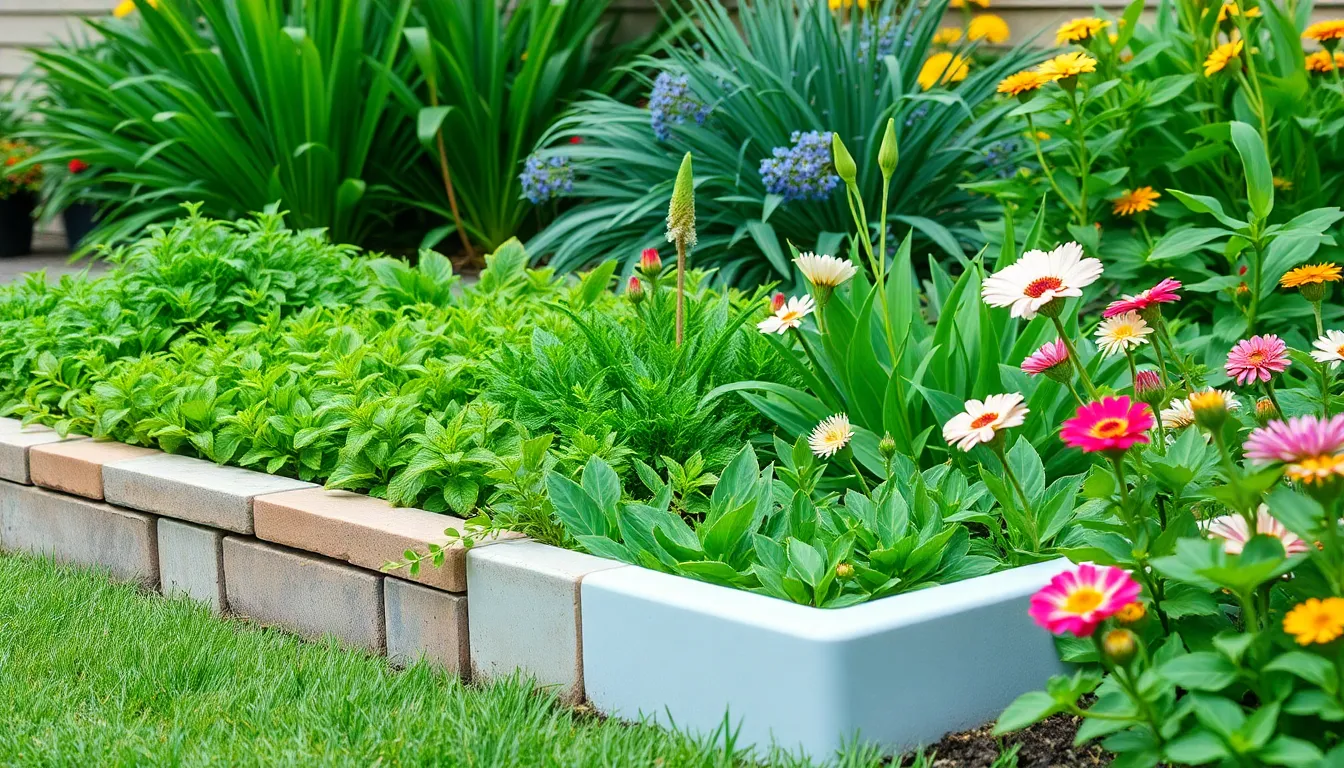
Australia’s diverse climate demands strategic material choices for long-lasting garden borders. We’ve identified the most effective answers for our unique weather conditions.
Drought-Resistant Materials
Concrete edging provides the most reliable solution for areas experiencing minimal rainfall throughout the year. This solid barrier maintains its structural integrity during extended dry periods while requiring virtually no water-based maintenance routines.
Brick edging delivers exceptional durability in drought-prone regions where traditional organic materials would fail. We recommend this classic option for homeowners seeking a timeless appearance that withstands Australia’s harsh dry spells without compromising visual appeal.
Stainless steel borders excel in tropical climates where moisture and humidity levels remain consistently high. These corrosion-resistant materials maintain their sleek appearance even though challenging environmental conditions.
Aluminum edging systems offer lightweight durability that’s particularly valuable in coastal regions. Their resistance to salt spray and moisture makes them ideal for Australian beachside properties.
PVC borders present a budget-friendly alternative for tropical areas, though they require more frequent maintenance compared to metal options. These flexible materials adapt well to ground movement while resisting moisture damage.
Weather-Resistant Treatments
Galvanized treatments significantly extend the lifespan of metal edging by creating a protective zinc coating that prevents rust formation. We’ve observed these treatments perform exceptionally well in Australia’s varied humidity levels.
Powder coated finishes enhance metal durability while offering color customization options for design-conscious homeowners. These treatments create an additional barrier against weather-related deterioration.
UV-treated plastics resist the intense Australian sun that can cause standard materials to fade and become brittle. We recommend these specially formulated options for areas receiving direct sunlight throughout most of the day.
Easy Edge systems incorporate no-dig technology with weather-resistant materials that simplify installation while maintaining long-term performance. These flexible answers adapt to seasonal ground movement without losing effectiveness.
Corten steel develops a protective patina layer over time that actually strengthens the material against further weather damage. This self-protecting characteristic makes it particularly valuable in harsh Australian conditions.
Seasonal Maintenance Requirements
Regular cleaning removes accumulated debris and dirt that can trap moisture against edging materials and accelerate deterioration. We schedule these maintenance sessions quarterly to prevent damage buildup.
Inspection routines help identify early signs of wear, cracking, or loosening that could compromise border effectiveness. Monthly visual checks allow us to address minor issues before they become costly repairs.
Vegetation trimming prevents plant overgrowth from damaging or displacing edging materials during peak growing seasons. This proactive approach maintains clean border lines while protecting our investment.
Drainage assessment ensures water flows properly around edging installations to prevent pooling that could undermine foundations. We check these systems before and after Australia’s wet season periods.
Budget-Friendly Australian Garden Edging
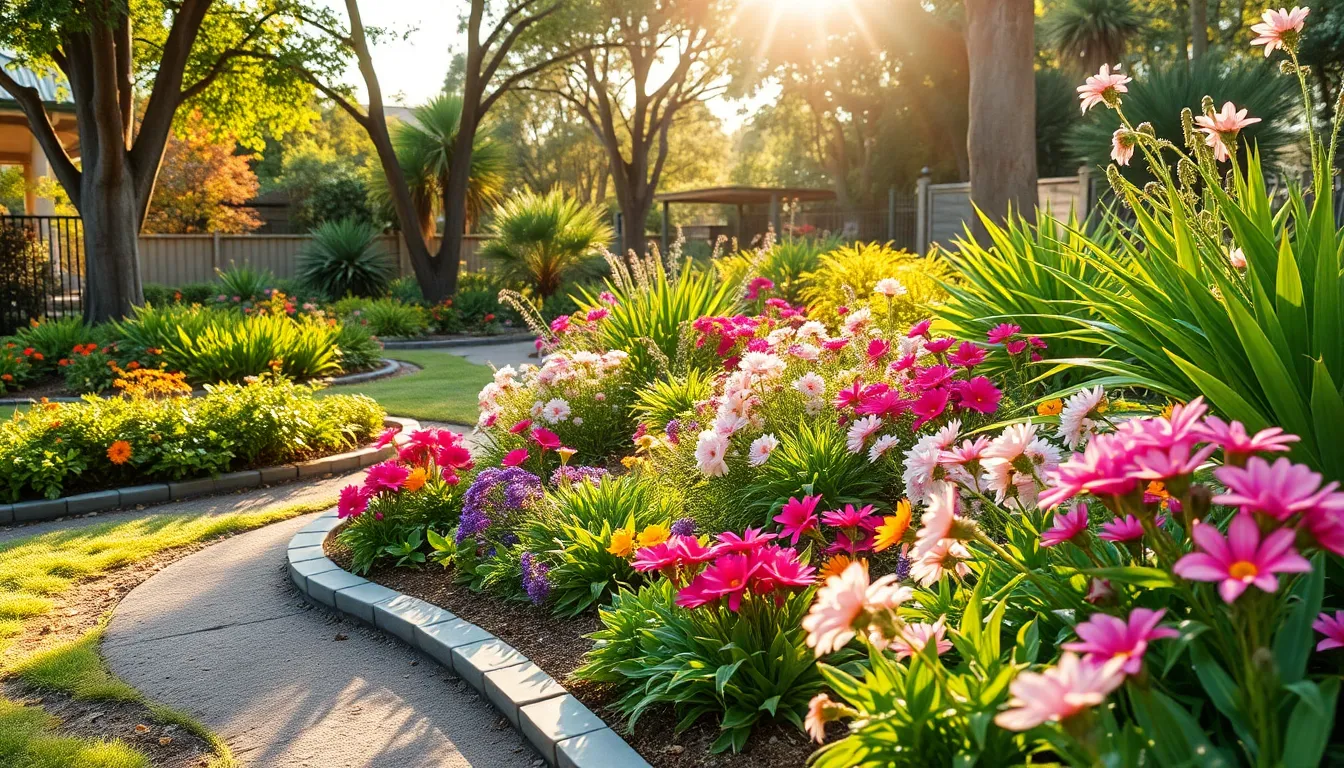
Creating attractive garden borders doesn’t have to strain your budget when you choose smart, sustainable options. We’ll explore cost effective answers that deliver professional results without the premium price tag.
Recycled Material Options
Recycled plastic edging stands out as our top sustainable choice for Australian gardens. Made locally from 100% recycled plastic, this edging option contributes to a circular economy and remains recyclable at the end of its life. You’ll find it particularly resistant to Australia’s harsh UV conditions while maintaining its color and flexibility.
Recycled PVC edging offers exceptional versatility for curved garden designs. Produced right here in Australia from recycled PVC materials, this flexible option resists insects and rot while bending easily around garden contours. Installation becomes effortless when you need to create organic, flowing borders that follow your industry’s natural lines.
Recycled rubber edging provides the ultimate DIY friendly solution through Easy Edge garden borders. These Australian made products use recycled rubber materials that flex with ground movement and weather changes. You’ll appreciate how this eco friendly option maintains its shape while supporting sustainable gardening practices.
Low-Cost Installation Methods
DIY no dig installation eliminates expensive excavation costs while saving you time and effort. Many Australian garden edging products, especially those made from recycled rubber, feature designs that simply press into existing soil. You can complete entire border projects in hours rather than days without hiring professional help.
Pegging and staking systems secure edging materials without complex tools or techniques. Looped pegs work excellently with flexible materials, while timber stakes provide solid anchoring for heavier borders. These fastening methods cost significantly less than concrete footings while offering reliable long term stability.
Cost-Effective Maintenance Tips
Regular inspection schedules prevent minor issues from becoming expensive repairs. Check your edging monthly for displacement, damage, or soil erosion that could compromise its effectiveness. Early detection saves money by addressing problems before they require complete border replacement.
Mulch retention strategies maximize your edging investment by preventing costly material spillage. Quality edging keeps mulch contained within garden beds, reducing the frequency of top up applications. This containment also prevents mulch from creating maintenance issues on pathways and lawn areas.
Mower resistant edging minimizes ongoing maintenance expenses by withstanding regular lawn care activities. Choose materials that resist mower damage to avoid frequent repairs or replacements. This durability consideration pays dividends over time through reduced maintenance costs and extended border lifespan.
Professional Installation vs DIY Approaches
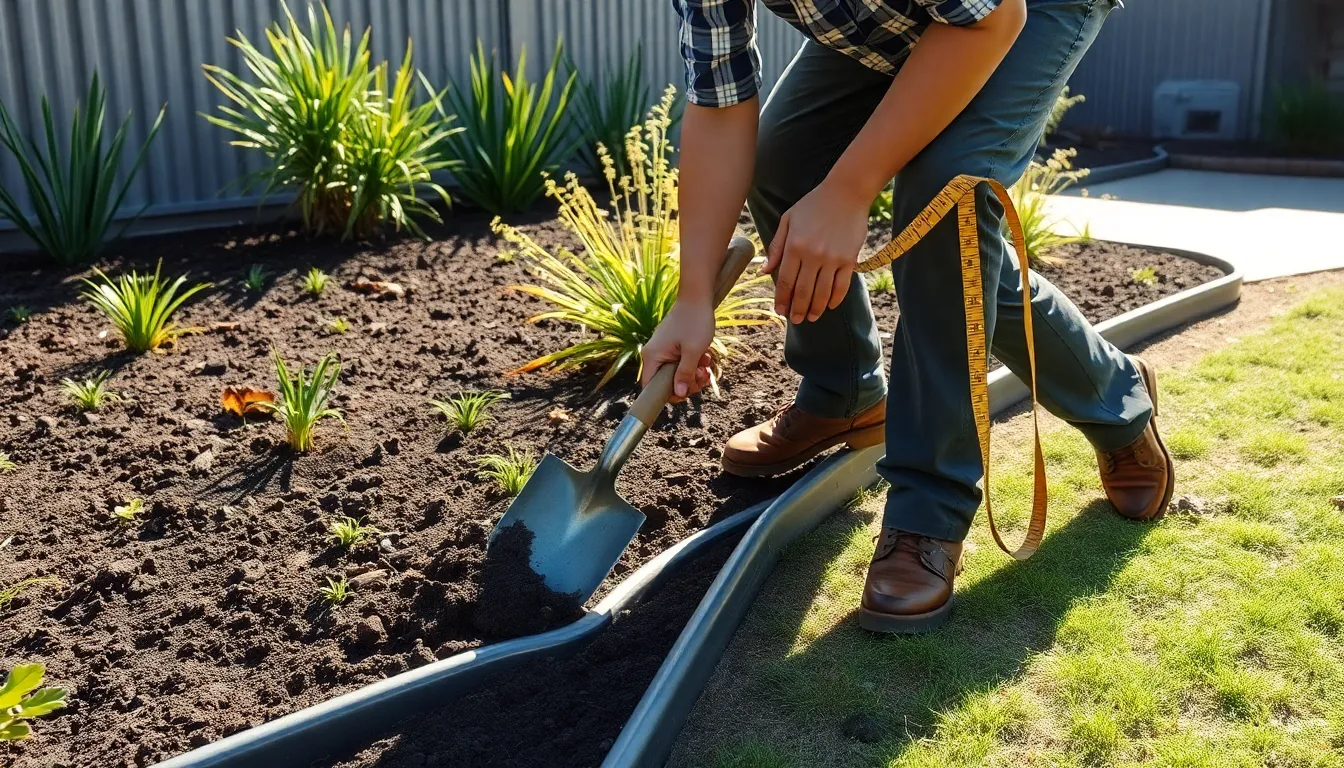
Most Australian homeowners face the choice between hiring professionals or tackling garden edging installation themselves. We’ll explore both options to help you make the best decision for your exact project needs.
When to Hire Professionals
Complex designs require professional expertise to execute properly, especially when intricate patterns or curved borders demand precision installation. Large scale projects spanning extensive areas benefit from professional crews who can complete work efficiently within reasonable timeframes.
Time constraints often make professional installation the smart choice when you’re juggling busy schedules or managing multiple home improvement projects simultaneously. We recommend considering professionals when your available time doesn’t match the project scope or complexity.
Skill level requirements vary significantly between different edging materials, with some installations demanding specialized knowledge beyond basic DIY capabilities. Professional installers bring years of experience handling challenging terrain, drainage issues, and material exact techniques that ensure long lasting results.
Essential Tools and Equipment
Garden edging material forms the foundation of any successful project, whether you choose steel, plastic, brick, or other options suited to your industry design. Quality materials make the difference between borders that last decades and those requiring frequent repairs.
Digging tools including shovels and trowels help you prepare proper foundations for most edging installations. Sharp spades work best for cutting clean lines through established turf areas.
Measuring tools such as tape measures and string ensure straight lines and consistent spacing throughout your project. We’ve found that proper measuring prevents costly mistakes and material waste during installation.
Safety gear including gloves and safety glasses protects you during installation, particularly when working with metal edging or sharp materials. Products like Inspire® Modern Garden Edging feature rolled top edges specifically designed for safer handling in pet friendly environments.
Step-by-Step Installation Guides
Mark the area using a garden hose or string to outline your desired edging path, allowing you to visualize the finished border before beginning excavation. This preliminary step helps identify potential obstacles and ensures smooth installation flow.
Prepare the ground by clearing vegetation and leveling the installation area to create stable foundations for your chosen edging material. Proper ground preparation prevents future settling and maintains clean border lines over time.
Install edging following manufacturer exact instructions, with products like Inspire® edging requiring simple hammering techniques that make professional results achievable for DIY enthusiasts. Each material type demands unique installation approaches for optimal performance.
Secure edging firmly in place using appropriate fastening methods to prevent shifting during seasonal weather changes or regular garden maintenance activities. Final positioning checks ensure your borders maintain their intended appearance and functionality for years to come.
Conclusion
We’ve covered everything you need to create stunning garden borders that’ll thrive in Australia’s unique climate. From natural stone and timber to modern metal answers and plant-based alternatives there’s an edging option for every budget and style preference.
The key to success lies in choosing materials that match your local conditions whether you’re dealing with coastal salt spray inland heat or tropical humidity. With the right approach and our step-by-step guides you can achieve professional-looking results without very costly.
Your garden transformation starts with that first border. Pick the solution that speaks to you grab your tools and start creating the outdoor space you’ve always wanted.
Frequently Asked Questions
What are the best materials for garden edging in Australia’s climate?
Natural stone (sandstone, bluestone, river rock), treated timber, metal options (Corten steel, galvanized steel, aluminum), and brick are excellent choices. These materials withstand Australia’s diverse weather conditions, from coastal salt spray to inland heat. Choose based on your local climate, budget, and garden style for optimal durability and appearance.
How much does DIY garden edging cost compared to professional installation?
DIY garden edging typically costs 50-70% less than professional installation. Budget-friendly options include recycled materials, PVC borders, and treated pine sleepers starting from $10-30 per meter. Professional installation ranges from $50-150 per meter depending on materials and complexity, making DIY an attractive option for cost-conscious homeowners.
Which edging materials require the least maintenance in Australian gardens?
Aluminum, Corten steel, concrete blocks, and native plant borders require minimal maintenance. These materials resist weathering, don’t need regular treatments, and handle Australia’s harsh conditions well. Aluminum and Corten steel are particularly low-maintenance, while native plants naturally adapt to local conditions without extensive care requirements.
Can I install garden edging without professional help?
Yes, most garden edging projects are suitable for DIY installation. Simple options like timber sleepers, brick borders, and metal strips require basic tools and minimal excavation. Follow step-by-step guides, use proper safety equipment, and consider professional help only for complex designs or large-scale projects requiring specialized skills.
What are the most drought-resistant edging options for Australian gardens?
Concrete blocks, brick edging, metal borders (aluminum, Corten steel), and succulent plant borders excel in drought conditions. These materials maintain structural integrity during dry spells and don’t require regular watering. Succulent borders like Echeveria and Sedum are particularly water-wise while adding natural beauty to garden edges.
How do I choose between natural stone and timber edging?
Consider your budget, garden style, and maintenance preferences. Natural stone (sandstone, bluestone) offers superior durability and weather resistance but costs more upfront. Timber provides natural beauty at lower cost but requires occasional maintenance. Stone suits formal gardens, while timber complements cottage or native garden styles perfectly.
What recycled materials work well for garden edging?
Recycled bricks, upcycled car tires, glass bottles, recycled plastic borders, and reclaimed timber create unique, eco-friendly edges. These materials reduce waste while adding character to gardens. Glass bottles create colorful borders, while recycled tires work well as planter edges. Most recycled options are budget-friendly and environmentally sustainable.
How often should I maintain my garden edging?
Inspect edging quarterly and perform seasonal maintenance. Check for loose materials, weed growth, and weather damage. Clean metal edging annually, reapply timber treatments every 2-3 years, and refresh mulch around borders regularly. Proper maintenance extends edging lifespan and maintains professional appearance throughout the year.

